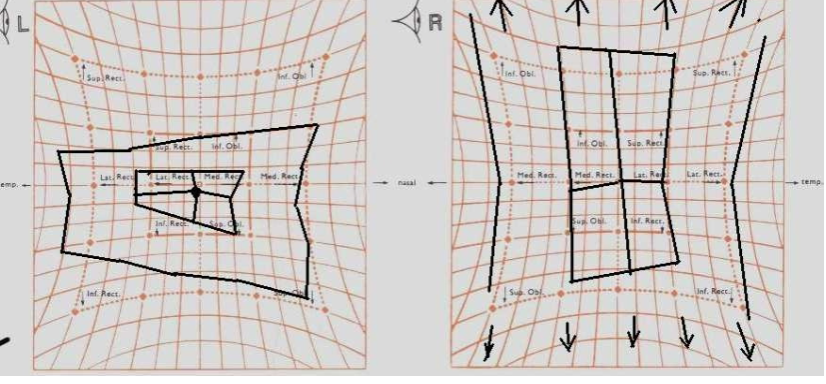orbital fractures
1/18
There's no tags or description
Looks like no tags are added yet.
Name | Mastery | Learn | Test | Matching | Spaced |
|---|
No study sessions yet.
19 Terms
A: Types of orbital fractures include:
Pure fracture: Only the orbital floor is fractured
Impure fracture: Involves the orbital rim
Other types: Blow-out fractures - orbital floor, medial wall, or both
naso-orbital fractures, orbital roof fractures, and zygomatic fractures
Q: What types of fractures are common in pediatrics?
Depressed fractures: A detached bone piece
Trapdoor fractures: A fracture where bone swings but doesn't fully detach
Linear fractures: Bone breaks and closes, trapping tissue (greenstick fractures)
What is the hydraulic mechanism in blow-out fractures?
buckling
hydraulic mechanism= increase IOP = Blunt trauma pushes the globe back, causing the orbital floor or medial wall to fracture.
buckling
They're a compression fracture, which means the break is caused by sudden pressure on a bone.
Blow-out (Smith & Regan 1957) - hydraulic
Q: What are common causes of blow-out fractures?
: Common causes include blunt trauma from sports, road traffic accidents, and assaults. These are most common in males in their 20s/30s.
Q: What are the eye symptoms associated with orbital fractures?
Diplopia (double vision)
Restriction in eye movement (due to muscle entrapment)
Enophthalmos (sunken eye)
Infraorbital anesthesia (tingling or loss of sensation)
Q: What deviations can occur with orbital fractures?
: Deviations can include hypotropia (downward deviation) or hypertropia (upward deviation) depending on the fracture.
Q: What are the periorbital signs of orbital fractures?
Periorbital signs include:
Bruising
Black eye (ecchymosis)
Subconjunctival hemorrhage
Crepitus (crackling sound)
Epistaxis (nosebleed)


Q: What is the Oculocardiac Reflex (OCR) in relation to orbital fractures?
: The Oculocardiac Reflex (OCR) is triggered by EOM traction, leading to bradycardia (decreased heart rate).
Q: When is immediate surgery indicated for orbital fractures?
Immediate surgery is indicated for severe cases such as:
Non-resolving OCR
Significant enophthalmos
Pediatric "white-eyed" fractures with muscle entrapment
Q: Why might late surgery be preferred for orbital fractures?
Late surgery may be preferred to:
Reduce risks of infection
Reduce risk of blindness
Assess late enophthalmos after edema has reduced
Q: What surgical techniques are used for orbital fractures?
FDT (Forced Duction Test) to assess mechanical restriction
Approaches: Trans-eyelid, trans-conjunctival, Caldwell-Luc (via the maxilla),
endoscopic
Medial wall exposure: incision can be used to expose the medial wall.
Periosteum incision: The periosteum is incised and elevated to expose the fracture borders.
Q: What conservative management options are available for orbital fractures?
: Conservative management options include observation, prisms for small deviations, or no immediate surgery for mild cases.
what are the feature of a white eye fracture?
a linear trapdoor blowout fracture - orbital wall fracture - in adults & children. Features:
Limited eye movement: Patients may avoid opening their eyes or looking up due to pain or nausea.
diplopia
Nausea and vomiting: This can be caused by the oculocardiac reflex.
Pain: Patients may experience pain during eye movement.
Lack of bruising: The name "white-eyed" refers to the lack of periorbital bruising and swelling that's often present.
No subconjunctival hemorrhage: This is a characteristic feature of a white-eye fracture.
White-eye fractures are considered a surgical emergency and require urgent surgery within 24–48 hours.
infection travels through sinuses = bruising
bone breaks and snap back = eyes look normal
ocular cardiac reflex - A triad of symptoms that includes bradycardia, nausea, and syncope. It's a rare but serious complication
check elevation - IR
white eye fracture + OCR = emergency
medial wall = thin = more susceptible to fracture = eso
inferior wall - hypo
spinchter restrict
radial dilate
Orthoptic investigation
diplopia - not always as can be too swollen to see
numbness - 5th CN damage - trauma to floor infraorbital anesthesia
ask about ocular cardiac reflex = IR trapped + SR
increase pressure to eye = faint
CHP = chin elevation - eyes move down = mechanical deviation
CT scan
pupil = traumatic mydriasis = pupil dilated slightly = mid dilated pupil
haematoma - bruising anywhere
conjunctiva bruising
if blood in anterior orbit = hyphaema
measure eye using exophthalmometer
CT w/ CHP = BSV
Common dev - hypo = pseudoptosis
pulling sensation
trap door fracture
scan looks normal
broken but goes back to where it was
severe
floor is gone = inset plate
completely breaks - eyes sink in - look lower
medial wall and lr can break - IR = trapped anywhere
measurement & tests
BSV
w/ CHP = normal BSV unless sublex lens - cornea scratch
PCT - 5 position of gaze
synoptophore
if obliques were affected = no torsion
MRI - soft tissue scan
CT scan look at bones
Hess chart - 2 stages of ms - affected = squashed
field of unioc fixation - mechanical restriction
field of BSV - surgery to stretch field of BSV
treatment
white eye
immediate emergency + ocular cardiac reflex
surgery release muscle - bc floor + wall provide no support - medial wall or sig wall entrapment = facial asymmetry
Diplopia
no muscle entrapment - just looks swollen - observe and occlusion
sig dip - surgery
cold compression
severe accident
wait till medically stable
late surgery
little to no opthalmus
sm diplopia
Criteria for orbital fracture repair
10- 14 days after onset
-sig diplopia
herination
incareraion/retraction
significant enophthalmos >3mm
Timing - immediate vs early vs late - burnstein 2002
immediate
Non-resolving oculocardiac reflex (e.g., bradycardia).
Significant enophthalmos (>3mm) or facial asymmetry.
White-eyed blow-out fracture (<18 yrs): minimal edema, marked restriction, tissue/muscle entrapment.
Early vs Late
Early: After edema/hemorrhage reduction; assess enophthalmos.
Late: Risk fibrosis; complications include blindness, infection, implant migration, diplopia.
Evidence
Simon et al. 2009: Minimal motility outcome differences between early and late surgery (limited data).
Management: Surgical and Conservative
FDT
Trans-eyelid
Trans-conj
Caldwell-Luc
Endoscopic
Conservative
Suspect soft tissue
Small deviation (elevation)
Prisms
Record progress prior to any surgical
intervention